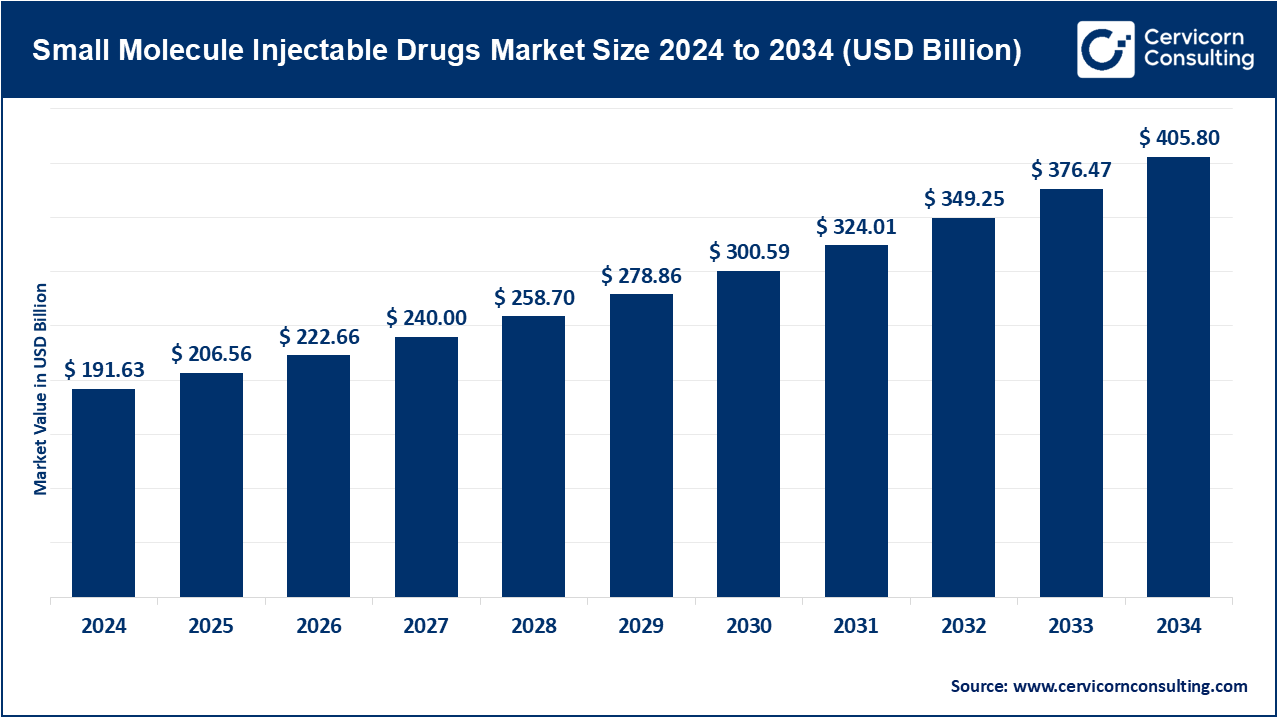Small Molecule Injectable Drugs Market Size
The global small molecule injectable drugs market was valued at approximately USD 191.63 billion in 2024 and is projected to reach around USD 405.80 billion by 2034, growing at a CAGR of 7.79% between 2025 and 2034.
What is the Small Molecule Injectable Drugs Market?
The small molecule injectable drugs market encompasses pharmaceutical products composed of low molecular weight compounds, typically less than 900 daltons, administered via injection. These drugs are pivotal in treating various conditions, including cancer, cardiovascular diseases, diabetes, and autoimmune disorders. Their significance lies in their stability, rapid absorption, and effectiveness, making them ideal for critical care and hospital settings.
Market Trends
-
Increased Demand for Oncology Injectables: The rising global incidence of cancer is driving the demand for injectable chemotherapy agents like paclitaxel and docetaxel. The World Health Organization projects a 60% increase in cancer cases by 2040, highlighting the need for effective injectable treatments.
-
Technological Advancements in Drug Delivery: Innovations such as prefilled syringes, autoinjectors, and long-acting formulations are enhancing patient compliance and convenience. These advancements are particularly beneficial for chronic disease management, allowing for self-administration and reducing hospital visits.
-
Regulatory Support for Accelerated Approvals: Regulatory agencies are streamlining approval processes for essential injectable drugs, especially in oncology and rare diseases. This support facilitates faster market entry for new therapies, addressing unmet medical needs more promptly.
-
Integration of Biologics with Small Molecule Therapies: The combination of small molecules with biologics is enhancing therapeutic outcomes, particularly in fields like oncology and immunotherapy. This integration is leading to the development of more effective and targeted treatment options.
-
Focus on Personalized Medicine: Advances in pharmacogenomics and biomarker identification are enabling the development of personalized injectable therapies. These tailored treatments aim to improve efficacy and minimize adverse effects, catering to the specific needs of individual patients.
Get a Free Sample: https://www.cervicornconsulting.com/sample/2705
Market Dynamics
Drivers:
-
Rising Prevalence of Chronic Diseases: The increasing global burden of chronic conditions is a significant driver for the small molecule injectable drugs market. These diseases often require long-term treatment, boosting the demand for effective injectable therapies.
-
Government Initiatives and Healthcare Expenditure: Increased healthcare spending and supportive government policies are enhancing access to injectable therapies. For instance, the U.S. spends over $12,000 per person annually on healthcare, facilitating the adoption of advanced treatment options.
-
Technological Advancements in Manufacturing: Innovations in manufacturing processes, such as continuous processing lines and automation, are improving the efficiency and scalability of injectable drug production, meeting the growing demand.
Restraints:
-
High Production Costs: The manufacturing of small molecule injectables involves complex processes and stringent quality control measures, leading to high production costs.
-
Regulatory Hurdles: Navigating the regulatory landscape for injectable drugs can be challenging, with varying requirements across different regions.
Opportunities:
-
Development of Long-Acting Formulations: The creation of long-acting injectable formulations offers the opportunity to improve patient compliance and reduce healthcare costs.
-
Emerging Markets Expansion: Expanding into emerging markets presents significant growth opportunities, driven by increasing healthcare access and the rising prevalence of chronic diseases.
Challenges:
-
Supply Chain Complexities: Ensuring a consistent and reliable supply of injectable drugs can be difficult due to the complexities involved in their production and distribution.
-
Patent Expirations: The expiration of patents for blockbuster injectable drugs can lead to market competition from generics, impacting revenue streams for original manufacturers.
Regional Analysis
-
North America: Dominates the market due to advanced healthcare infrastructure, high healthcare expenditure, and a strong presence of key pharmaceutical companies. The U.S. alone accounts for a significant share of global healthcare spending, facilitating the adoption of innovative therapies.
-
Europe: Exhibits steady growth, driven by favorable government policies, high healthcare standards, and an aging population. Countries like Germany, France, and the UK are leading contributors to the market.
-
Asia-Pacific: Expected to witness the highest growth rate, attributed to a large patient pool, increasing healthcare investments, and rising prevalence of chronic diseases. Nations like China and India are emerging as significant markets for injectable drugs.
-
Latin America and Middle East & Africa (LAMEA): While currently smaller markets, they are showing potential due to improving healthcare access and infrastructure developments.
Recent Developments
-
Regulatory Approvals: Agencies such as the FDA and EMA have granted accelerated approvals for several small molecule injectable drugs, expediting their availability to patients.
-
Product Launches: Pharmaceutical companies are introducing new injectable formulations, including long-acting and combination therapies, to address unmet medical needs.
-
Strategic Partnerships: Collaborations between biotech firms and pharmaceutical companies are fostering innovation in drug development and delivery technologies.
-
Market Expansions: Companies are expanding their presence in emerging markets through joint ventures, acquisitions, and local manufacturing initiatives.
The small molecule injectable drugs market is poised for substantial growth due to technological advancements, rising prevalence of chronic diseases, and supportive regulatory environments. Companies that focus on innovation, cost-effective manufacturing, and expanding access to emerging markets are expected to capitalize on the evolving opportunities in this dynamic market.
For more detailed insights, contact us: Contact Us
Read: Nuclear Fusion Market Innovations, Investments and Opportunities

